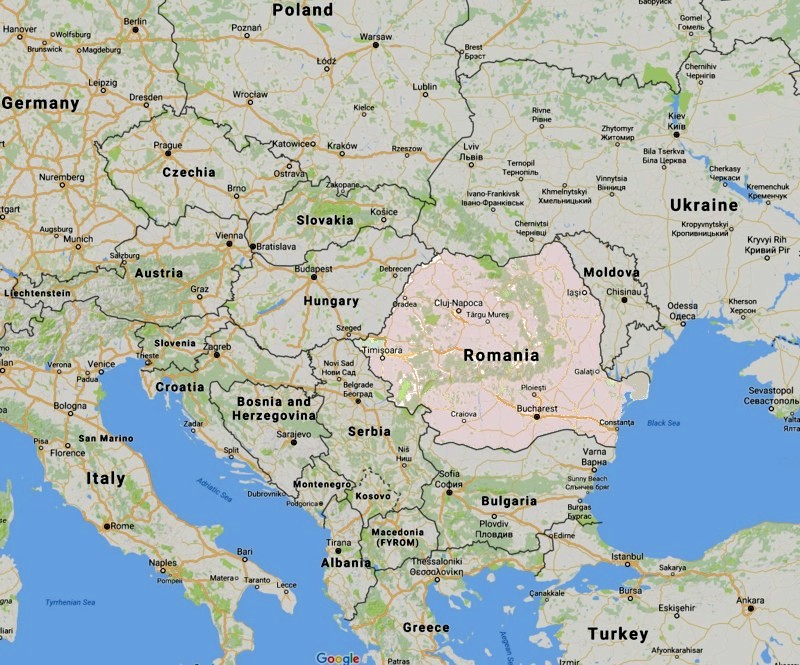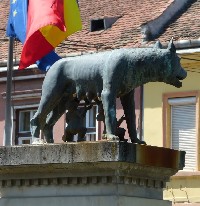In October 2016 we flew from southern England to Romania.
Romania is a big country by European standards and not one to see by public transport if time is limited. So to travel beyond Bucharest we hired a car and drove northwest to Brașov and on to Sighisiora, before looping southwest to Sibiu (European capital of culture 2007) and southeast through the Transylvanian Alps to Curtea de Arges on our way back to Bucharest.
Driving in Romania was interesting. There are some quite good motorways once out of the suburbs of Bucharest, where traffic lights are interminable trams rumble noisily, trolley-busses stop and start and progress can be slow. In the countryside road surfaces are variable and the roads mostly narrow. This does not slow the locals who seem to ignore speed limits making it necessary to keep up to avoid holding up traffic.
Initially the TomTom (GPS navigation device) that we now carry with us from OZ, thought we were still in England. When it asked if we wanted to avoid ferries I answered 'yes' and was told there was no available route to Bucharest - where I was standing at the time. Not until I asked for the nearest petrol station did it relocate itself. I thought it was an amusing TomTom idiosyncrasy. From then on it was invaluable.
 Locating Romania
Locating Romania
Visiting Romania
We saw no signs advertising lions in Romania, like those pointing to Longleat during our recent sojourn in Southern England, but our guide-book represented the local bears as being just as dangerous.
The next most dangerous thing in Romania is Dracula, who is represented in all the tourist areas in myth and legend. That he was the imaginary character of Abraham 'Bram' Stoker, an Irishman writing a novel in the British Library in London, is immaterial to the tourist potential of the story. To give the fictional story some semblance of real world plausibility Dracula is said to be based on the real life 15th century Romanian aristocrat and soldier Vlad III, Prince of Wallachia, a member of the House of Drăculești and therefore known as Vlad Drăculea.
Vlad III was better known as Vlad the Impaler for mounting his captured enemies vertically on a spike up through their body. This was at the time of the Crusades when such behaviour was not unusual and Vlad, a Christian knight, had much vaunted success against the Ottoman Turks, according to graphic recreations, skewering quite a few. But there is nothing whatever to associate him with the drinking of blood - unless it was at mass.
Romania is a big country and the circular 'tourist' route we took was largely within the picturesque Transylvanian region that also happens to be the wealthiest and best educated part of the Country.
Much of Transylvania seems 'first world' with well tended houses and well-dressed healthy-looking people going about their business. Yet at regular intervals this image is contradicted by poor local farmers out on the roads with carts and other horse-drawn vehicles, occasionally tipped over in a ditch.
But these farmers are fortunate compared to the people who walk for miles. These very poor people are in contrast to the generally late model German and French cars sharing the road with them.
Romania has one of the fastest economic growth rates in Europe (off a low base) and low rates of unemployment, yet the new wealth is evidently quite uneven in this once communist country.
Some villages, are obviously poor and decrepit with no evident services like electricity. Şaroş pe Târnave, in the pictures below, is a paradise compared to others we saw but didn't approach.
Şaroş pe Târnave - Romania
Wealthier villages in this region closely line the roads in a side-by-side distinctive Romanian style, each with a large door or carriage entrance giving into an internal courtyard.
Farming seems to be efficient. Large fields of corn are commonplace but we also saw hops being grown on a large scale. Houses on larger rural properties are well-appointed, evidently prosperous, an Audi or BMW parked alongside modern tractors and farming equipment.

